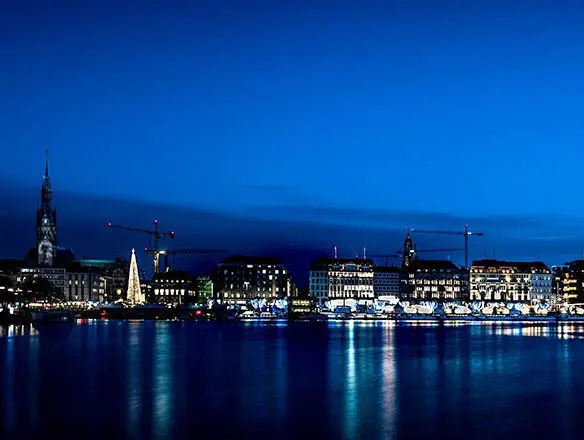
1. Introduction
Welcome! Welcome to Hamburg! Almost completely destroyed during the Second World War, Hamburg was reborn from its ashes to become a prosperous city full of attractive places for the visitor. This Hamburg audio guide will help you to visit one of the most important and vibrant cities in Germany. Will you accompany me?
Since Hamburg joined the Hanseatic League in the Middle Ages, it has always been a city dedicated to trade with the rest of the world. It reached its splendor as a center of international trade during the 19th and early 20th centuries, only to fall into oblivion after the devastation it suffered due to the Allied bombings during World War II. More than 70% of the city was reduced to rubble by the bombs that the English and Americans dropped on Hamburg during Operation Gomorrah.
Tenacity and hard work - classic Germanic values - managed to rebuild a city that became rich again thanks to its great commercial port traffic. Not surprisingly, its cargo port is the second busiest in Europe - after Rotterdam - and the ninth in the world.
Today, Hamburg is the second most populated city in Germany. Its port plays a major role, and you will find bars, restaurants, pubs, and a lot of multicultural life nearby. Museums, parks, elegant stores, and imposing buildings complete an offering you can't miss.
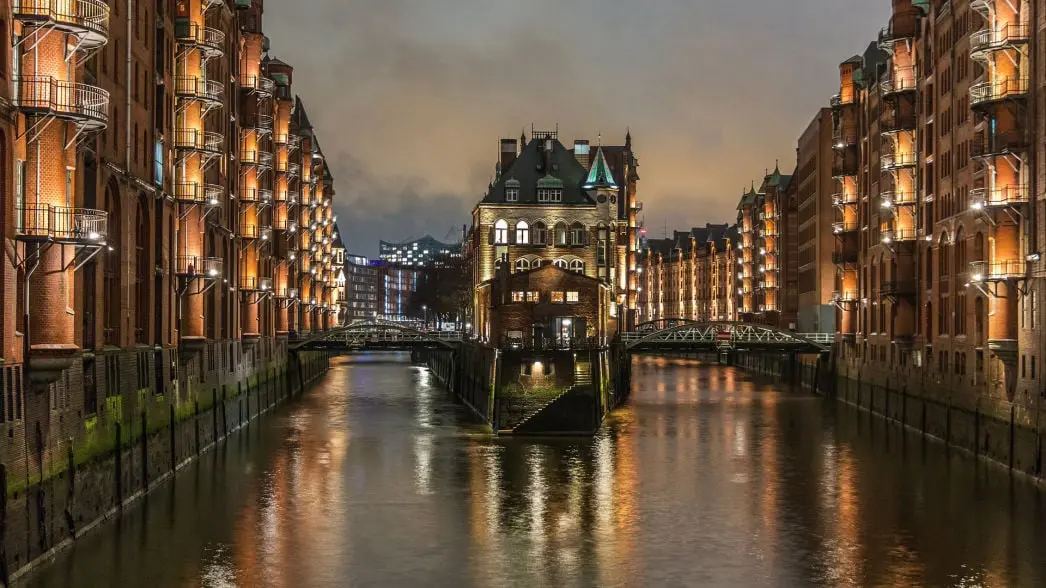
2. The Impressive Port of Hamburg
With the audio guide in hand, let's start our tour of an iconic place in Hamburg. The port of Hamburg is a seaport, despite being about 110 km from the North Sea. It is also the largest in Germany, the second-largest in Europe, and the ninth-largest container port in the world, with a container volume of almost 10 million. Up to 320 ships can dock here. The total area of the port covers 7399 hectares.
The port of Hamburg was founded by the Count of Schauenburg in 1189. In 1321 Hamburg became part of the Hanseatic League, which boosted its maritime and commercial activity, quickly making it the most important port between the Baltic Sea and the North Sea. Near the end of the 19th century, Hamburg became the most important city on the entire European continent in terms of maritime trade. In 1888 the duty-free port was born and with it the still used warehouse district.
In 1847, HAPAG, the Hamburg-America Line, was founded, so the port of Hamburg became important as a passenger port. Many emigrants and Jews settled temporarily and then left for America.
Despite its shining past, the port of Hamburg has an air of modernity that distinguishes it from other European cities. In few cities can one can visit several historical ships, among them an authentic Soviet submarine, and see so many impressive freighters. The activity in the river port is frenetic. The traffic made up of river barges, ocean-going freighters, pleasure boats, or the ferries that serve as water buses is continuous.
Taking a boat tour is a highly recommended option for discovering the city and port activity from another angle. In the port, there are also several nautical museums to be visited.
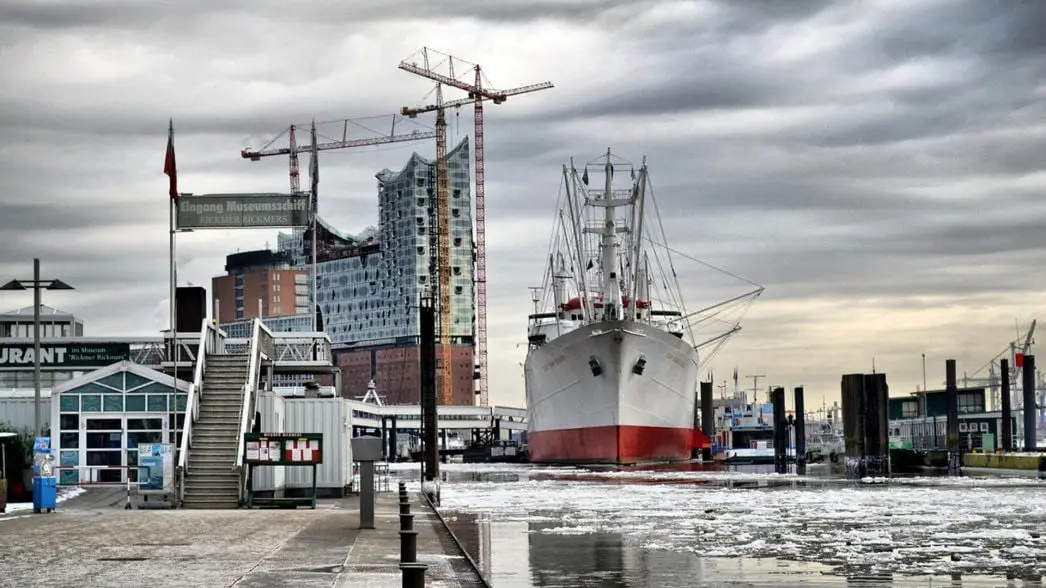
3. Speicherstadt
One of the most important places to see in the Hamburg harbor is the Speicherstadt (literally, storage city). This neighborhood is famous for having the largest warehouse area in the world. Declared a World Heritage Site, it was built between 1883 and 1927. The red-brick Gothic style warehouses stand out, which you can enjoy even more by taking a boat trip through its narrow canals.
You will find restaurants, stores, art galleries, and numerous museums here. Among them are the International Maritime Museum, the Warehouse District Museum (Speicherstadtmuseum), the German Customs Museum (Deutsches Zollmuseum), the Museum of Miniatures (Miniatur-Wunderland) or the Spice Museum (Gewürzmuseum). Another place of interest is the new Philharmoniker Hamburg, whose audio guide you can hear in a future section.
Another surprise that this neighborhood has in store for us is the Chilehaus, whose literal translation means "the house of Chile." It was inaugurated in 1924 and when you look at it from the front, you get the impression you're looking at the bow of a ship. It is an example of the architectural movement known as "expressionism in brick" from the 1920s.
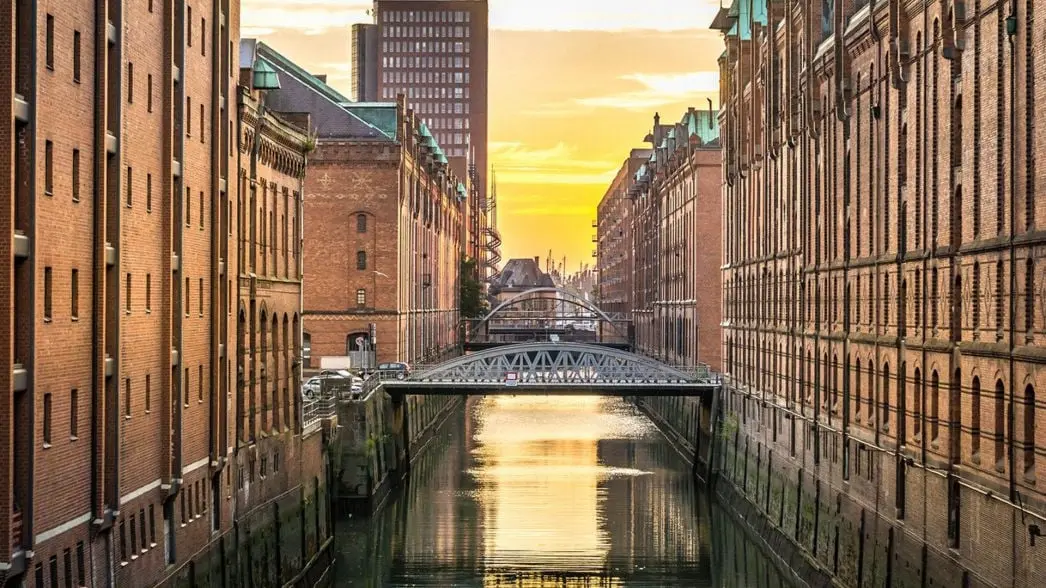
4. The International Maritime Museum
Considering Hamburg is one of the most important ports in the world, it is not surprising that it houses such a spectacular museum dedicated to the sea.
Located in the oldest warehouse in the city and declared a World Heritage Site, the International Maritime Museum is one of the most important places to see in Hamburg. Called Kaispeicher B, it was built in 1878 and was used as a warehouse until 2003.
This museum opened its doors in 2008. It was created by the German journalist, director, and editor Peter Tamm. In its 16,000 square meters, spread over 10 levels, it exhibits one of the world's largest collections of ships and objects documenting more than 3,000 years of shipping history. In total, some tens of thousands of objects on display will let you discover models, original charts (including those of the English Admiral Nelson), maritime art objects, the history of merchant ships, research on the marine world, the development of naval engineering, the history of sailing ships, and much more.
In this audio guide, we recommend starting the visit at the top level. One of the most important floors is the 9th, where you can find Peter Tamm's private collection: it contains miniature ships from all nations, all naval battles, and all the ports of the world. In the center of one of the rooms, inside a glass urn, you will find the first piece of the whole collection, a 1:1250 scale miniature of a coastal motor-boat that was the collector's first acquisition.
In level 8 you will discover the treasure chamber where the museum's most valuable objects are displayed: some models of ships made of gold, silver, or amber. But without a doubt, the most remarkable is a pure gold miniature of the Santa Maria, the largest of the three vessels with which Christopher Columbus arrived in America. There is also a collection of bone ships, unique in the world.
On the 6th floor, you can find models depicting the evolution of goods and passenger transport ships, as well as a model of what is perhaps the most famous ship on the planet, the Titanic.
Another floor you can't miss is level 1, where you will find a giant model of the QUEEN MARY 2 made with 780,000 pieces of LEGO. This will undoubtedly be the favorite area for children and children at heart, and one of the most unique things to see in Hamburg!
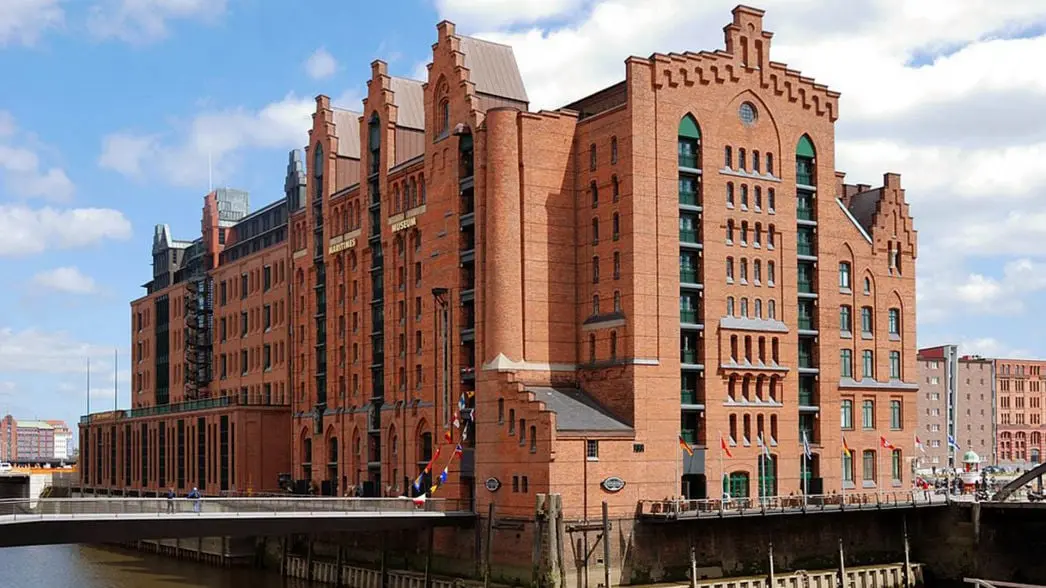
5. Hamburg City Hall
Now, as you listen to this audio guide, head over to the monumental City Hall Square, where you will find the Rathaus or Town Hall
Hamburg City Hall is one of the most recognizable silhouettes of the city. It was built at the end of the 19th century, during the time of the city’s greatest prosperity, after a fire destroyed the previous city hall.
Its neo-Renaissance facade is adorned with statues of emperors and is crowned by a characteristic green roof. The tower is about 112 m high and the building has 647 rooms. Access to the lobby is free and you can admire classical portraits, sandstone pillars, and an elegant marble staircase. You can also access free of charge the building’s courtyard where there is one of the most beautiful fountains to see in Hamburg representing Hygia, the Greek goddess of health, which was erected in memory of the cholera epidemic that hit the city at the end of the 19th century.
Currently, the building has several uses, with the political powers of the city coexisting with exhibition or concert halls.
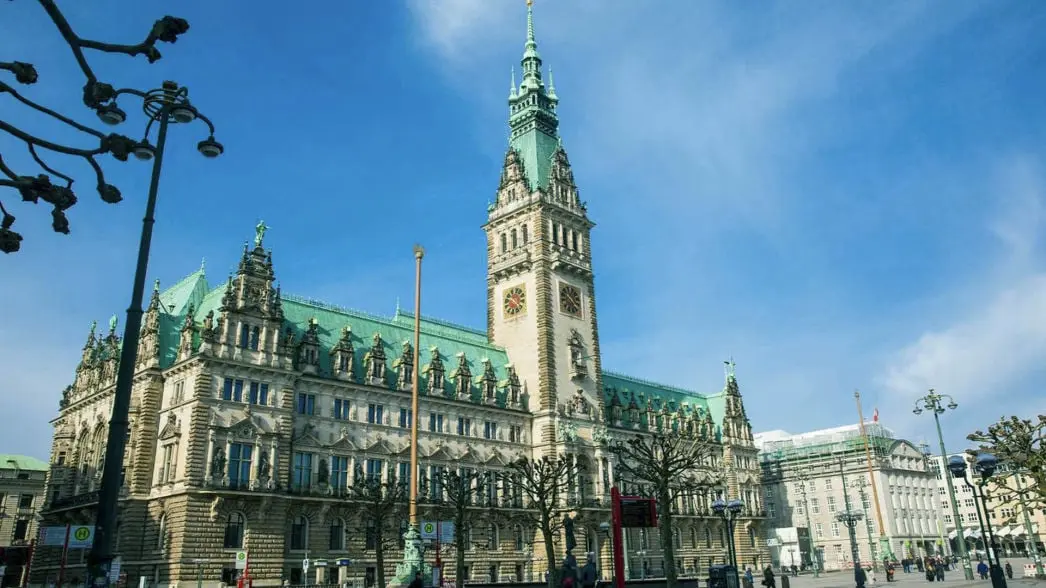
6. Saint Peter’s Church
Very close to the City Hall is St. Peter's Church, which is the oldest parish in Hamburg. It is very special both for its history and for the pieces of art it houses.
There was already a church dedicated to St. Peter in this location since the eleventh century. Around 1310, the cathedral was rebuilt in the Gothic style and was completed around 1418. The oldest and best-known works of art in St. Peter's church are the bronze lion-headed doorknobs of the western gate, which date back to 1342 when the tower was built.
In 1516, a second tower was even built above the Hamburg Cathedral. Its deterioration caused it to be demolished between 1804 and 1807, after having been used by Napoleon's soldiers as a powder magazine and stable. The building was then a victim of the great fire that swept Hamburg in 1842. Most of the works of art were saved, such as the aforementioned lion-headed door handles. The doors of St. Peter's gate were severely damaged by fire, but were rescued and ended up being integrated into the Hamburg History Museum.
Only seven years after the great fire, in 1849, the Gothic church was rebuilt by the architects Alexis de Chateauneuf and Hermann Felsenfest in its previous location. The reconstruction was done with some of the bricks from the previous structure, hence some are darker than others. In 1878, the spire was completed with a 132-meter high copper roof on the cathedral tower, designed by Johann Maack. It survived World War II with relatively little damage.
With the audio guide in hand, visit the Christmas 1813 painting, which you will find on a column in the southern part of the church. It depicts the citizens of Hamburg who were locked inside the church by Napoleon's troops after refusing to provide food to the soldiers.
St. Peter's bell tower constitutes one of the highest viewpoints of the city. If you manage to overcome the 544 steps, you will enjoy a spectacular view of the Rathausmarkt (city hall market) and Lake Alster.
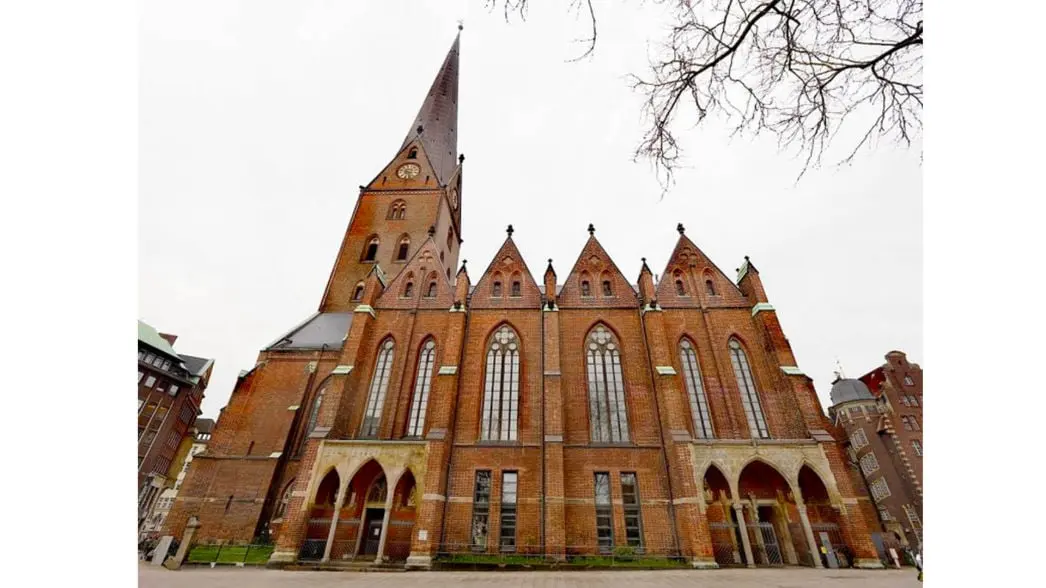
7. Deichstrasse
Deichstrasse is one of the most picturesque streets of the city and another place to see in Hamburg. Located on the banks of the Nikolaifleet canal, between the church of St. Nicholas and the port, is full of old fairytale houses, with Dutch-style facades built from the seventeenth to the nineteenth century, which still remind us of old Hamburg.
Many of the houses withstood the World War II bombing and although others have been rebuilt, this does not take away the charm or the feeling of moving back a few centuries, as you go through it with the audio guide.
This street is where the fire of 1842 was discovered, specifically in the Großes Feuer (Great Fire) restaurant building. The merchant houses from the 17th and 18th centuries are mainly taverns, today. You can enjoy a good view of the entire facade from the Hohe Brücke. Traces of the floods of 1962 and 1976 can still be seen on the walls.
On the other side of the canal is Cremon Street, another of Hamburg's not-to-be-missed streets.
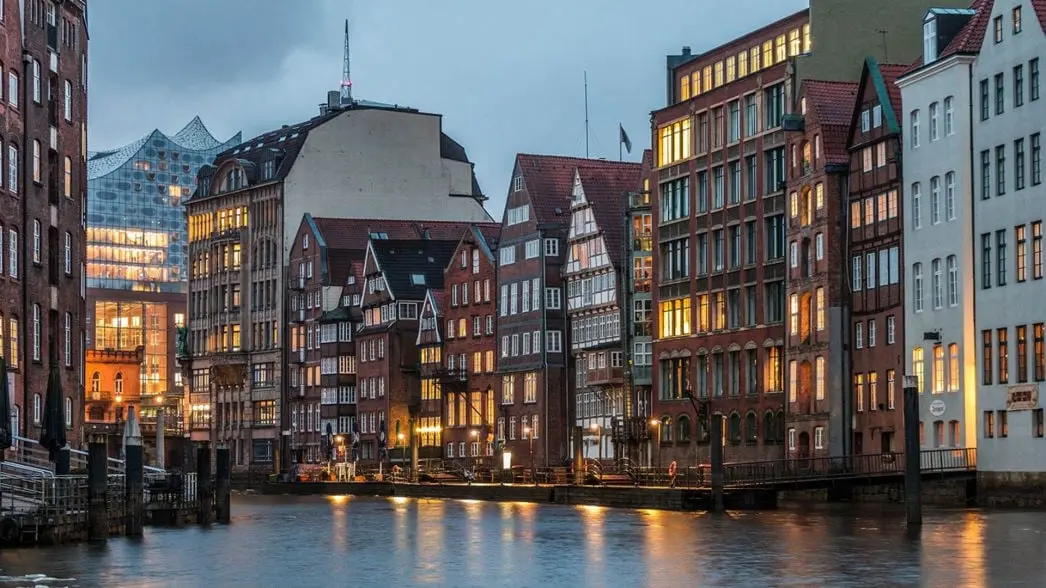
8. St. Michael’s Church
The next stop for the audio guide, St. Michael's Church is one of the five main Protestant churches in Hamburg and a symbol of the city. It is popularly known as "Der Michel," and was built under the patronage of St. Michael the Archangel. In fact, before entering the church, be sure to look up to see the statue above the portico, which shows the Archangel conquering the devil.
Like many other traditional buildings in Hamburg, the church tower is completely covered in bronze, so it takes on a peculiar green color. With a height of 132 meters, it is also a landmark for all those navigating the Elbe River.
'Michael' is the third church to be built on this site. The original 17th-century church was destroyed by a powerful lightning bolt, and the second one burned down when it was attempted to rebuild it in 1906. Soon after, work began on the current church. The decision was made to rebuild it keeping the original model and structure, but no longer covering it with the traditional woods but with steel from that time, reopening its doors in 1912.
If you want to enjoy a breathtaking view of Hamburg, climb the 453 steps of the Clock Tower. You can also get there by elevator. This tower has a clock 2.5 meters in diameter whose hands are covered with gold leaf.
Those who do not like heights can go down to the crypts under the church. From 1762 to 1817, many members of the city's wealthy families, the parish community, and guilds were buried in these crypts. One of them was the famous composer Carl Philipp Emanuel Bach, son of Johann Sebastian Bach. The interior of the church also has 5 organs.
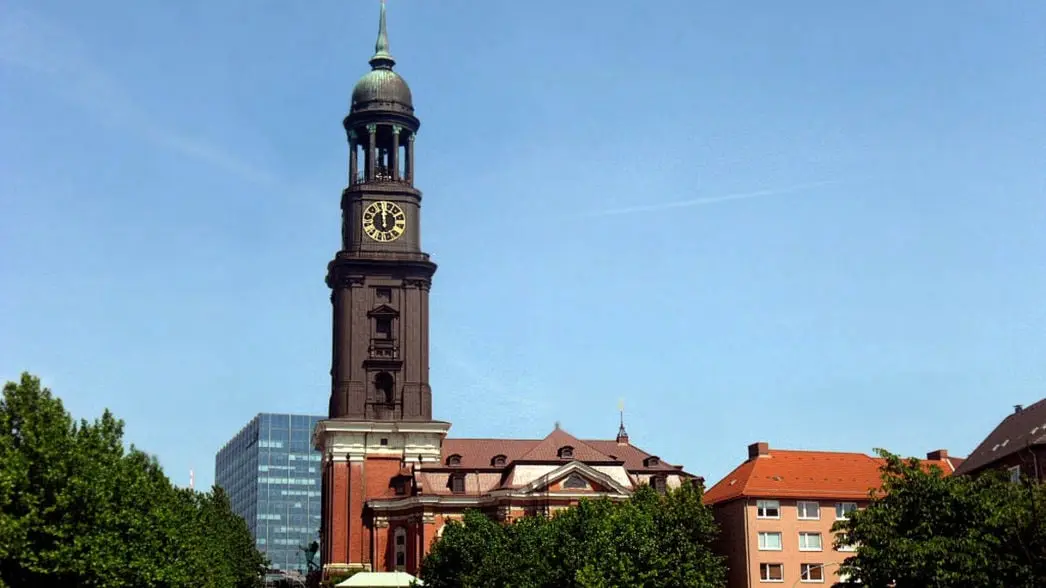
9. Alster Lakes
The Alster River forms two artificial lakes in Hamburg: the Binnenalster and the Aussenalster, known together as Alster Lakes.
Binnenalster, or Inner Alster, is the smallest and closest to City Hall Square. It has a fountain in the middle and you will see many ducks and swans while walking along the lake's shore.
Aussenalster (Outer Alster) is separated from the Binnenalster by two bridges. It is the fun zone, where visitors and locals practice water sports and walk the trails that surround it. Set the audio guide aside for a moment, and relax! You can take a boat or canoe ride, go for a bike ride or have a picnic accompanied by a great German beer in its green zone. Don't forget to take a good German sausage sandwich with you to renew your strength after your workout!
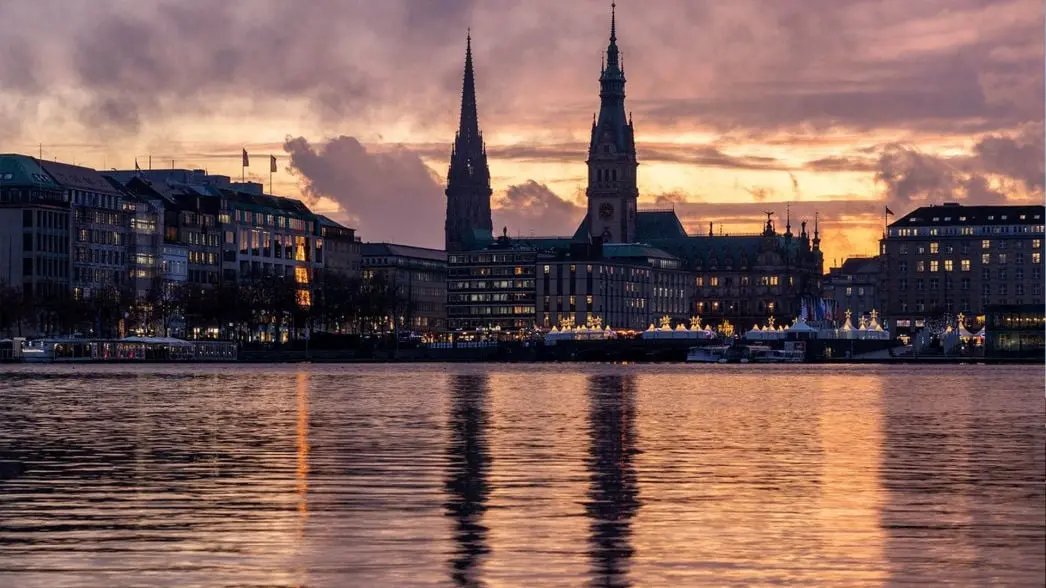
10. Krameramtswohnungen
If you would like to discover Hamburg's past and appreciate its historical treasures, a visit to the old Krameramtswohnungen is an activity not to be missed.
These are old houses from the 17th century, located around St. Michael’s Church, which were used by the small merchants of the area at that time. Although the passing of the years and urban transformations have threatened the original structure of these houses, it is still possible to visit one of the original Krameramtswohnungen. With the audio guide, you will travel back in time through the 1850 furnishings that can be seen in them.
The Krameramt was a group of small merchants who had their stalls or stores in the city and traded mainly in spices, silk fabrics, and iron goods. In 1676, the rich Kramer Office had free apartments built for 20 widows of deceased members. The construction of these accommodations was not only for social reasons. At the same time, it was also in the Krameramt's interest to move widows or unfit co-workers from the stores, in order to allow the arrival of new traders, as women at that time were not allowed to have businesses.
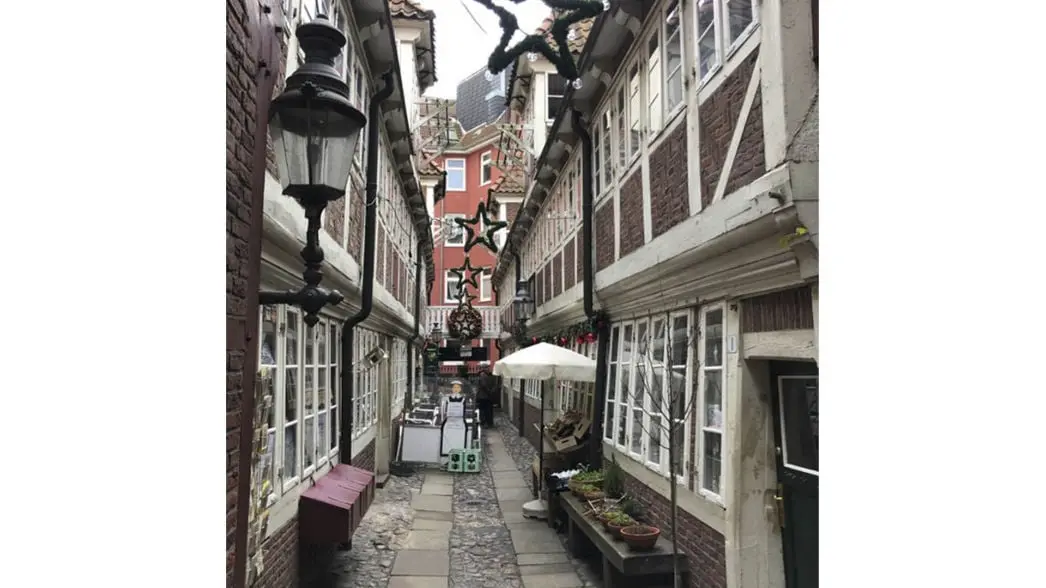
11. The St. Pauli Quarter
Now let the audio guide take you to St. Pauli, one of the most famous and largest red-light districts in Europe, surpassing even that of Amsterdam. It is the liveliest side and another of the must-see places in Hamburg. Its most famous street is Reeperbahn, known as "the sinful mile" of the Red Quarter, although around Hans-Albers-Platz and Herbertstrasse and Grosse Freiheit streets, much of the nightlife of the city is also concentrated.
St. Pauli has been transformed over the years and more and more modern venues have emerged in the form of bars, restaurants, and theaters, which have made it an area for all audiences and the preferred place to spend a fun night.
One of the most curious anecdotes of the neighborhood is that the Beatles played in several clubs in this neighborhood before becoming famous. In fact, at the intersection of Reeperbahn and Große Freiheit, you will find Beatles-Platz. The square is circular and has black pavement, which gives the impression of walking on an old vinyl record. Around it, you will discover the five figures of John Lennon, Paul McCartney, Stuart Sutcliffe, George Harrison, and a hybrid of the drummers Pete Best and Ringo Starr.
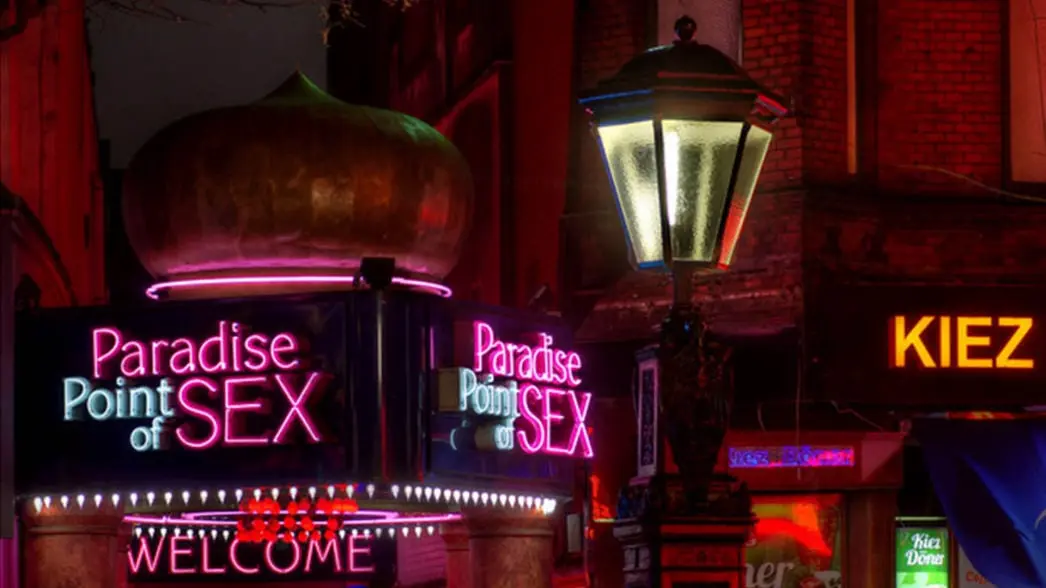
12. Planten un Blomen
The next destination of our audio guide, Planten un Blomen, "Plants and Flowers," is a huge park and botanical garden located near the city center. With about 47 hectares of land, Plamten un Blomen is the most beautiful park to see in Hamburg.
This green lung of Hamburg has several outstanding areas. One of them is the Japanese garden, which is the largest in Europe, and which mixes flowers and trees with water. You will also find an endless number of tropical plants, a greenhouse, a large lake, water games for children, and of course, a bar for a good beer.
It is a perfect place to take a relaxed walk, and take advantage of a sunny day to lie down in one of its loungers.
Also note that the park's lake offers one of the best light and water shows to be seen in Hamburg.

13. Elbphilharmonie
Elbphilharmonie is a concert hall that stands out for the incredible architecture of its building and has become the emblem of the new Hamburg. If you have the opportunity to go to a concert, you will see that its acoustics are impressive. Otherwise, you can enjoy free access to the large terrace with panoramic views over the port.
Designed by the prestigious Swiss firm Herzog & De Meuron, it had multiple delays and incalculable cost increases, which led the Hamburg City Council to hold a referendum for the city's inhabitants to choose whether or not to complete the project. It was finally completed in October 2016 and inaugurated in January 2017.
The building rests on a renovated warehouse of vast dimensions (Kaispeicher A), typical of the Speicherstadt, built in 1963. The facades and exterior elements are made of glass and have adjustable and programmable mechanisms. Its design is intended to imitate the shapes of a hoisted sail, a sea wave, an iceberg, and a quartz crystal.
At the end of this visit, remain in the area and take the opportunity to discover another unique museum, the Miniatur-Wunderland Museum, which we will briefly describe in the following audio guide point.
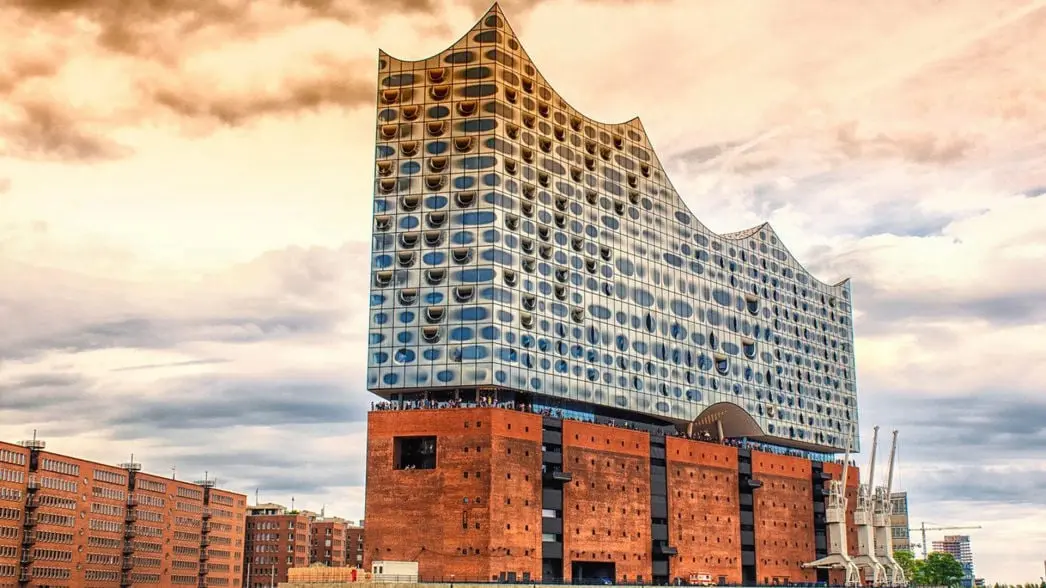
14. Miniatur-Wunderland Museum
Forget what you understand by a miniatures museum. When you enter Miniatur-Wunderland, your audio guide will fall to the floor and you will be speechless!
This museum is impressive. More than a million visitors a year is a guarantee that few others can present. In an exhibition that covers about 1,300 m², you will travel through countries and continents employing miniature trains, in the middle of incredible models that faithfully reproduce places like the Alps, the Grand Canyon, or the Scandinavian countries.
Each Miniatur-Wunderland day lasts 15 minutes and in that time you will see: police chases, planes taking off and landing at the first truly operational miniature airport, firemen putting out fires, trains, trucks, soccer games, a couple of lovers making love in a motor home in the middle of a field of sunflowers, a lumberjack cutting down a tree that falls on the roof of his own house... It is a world of magic in miniature.
If you travel with your family, it should be at the top of your list of things to see in Hamburg!
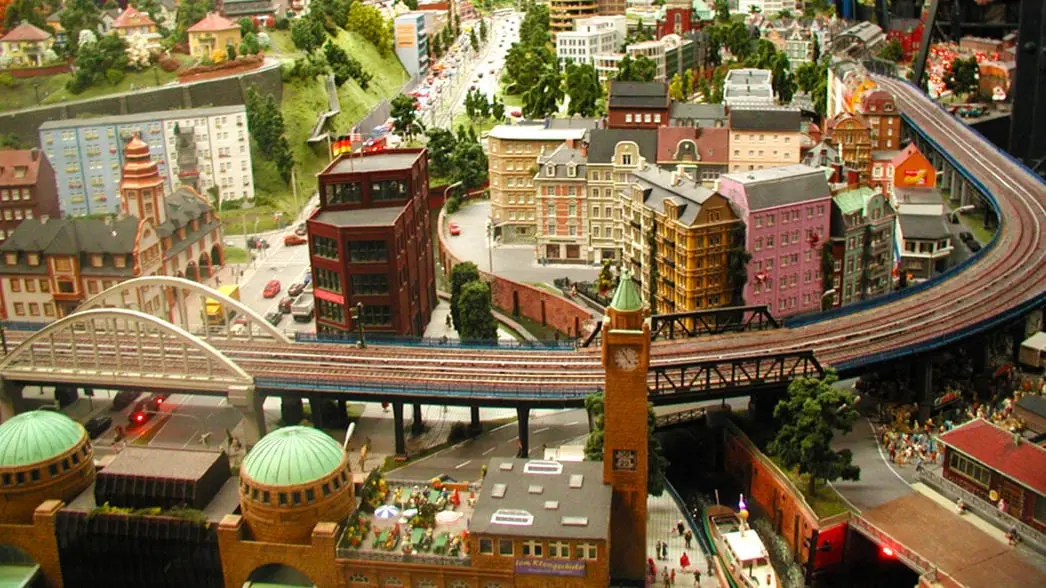
15. Fischmarkt
If you visit Hamburg on a Sunday you can't miss the most famous market in the city, the Fischmarkt. This popular fish market has been in operation since 1703 and opens at 5 am in the summer. If you find it difficult to get up early, visit it right after a night out in the nearby Red Light District!
Every Sunday, up to 70,000 people, including locals and tourists, attend the fish auction. The Marktschreir begin to show the product and sing the prices to bring the auction to life. It is a great show that is enlivened by the old German pop music played by some live bands.
You will also find fruit, plants, and clothes in the market at a good price, as well as a unique atmosphere, which justifies your visit by itself. Although the stalls close at 9:30 in the morning, you can always enter the market building to have a coffee or hot chocolate and breakfast while listening to live music or the following audio guide clips!
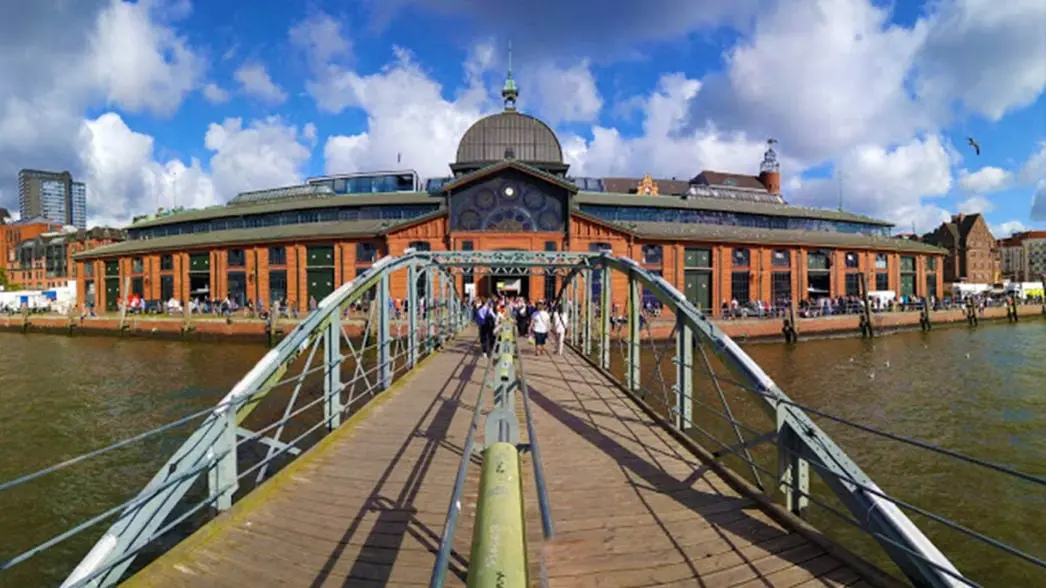
16. Elbe Tunnel
Old Elbe Tunnel is one of the biggest attractions to see in Hamburg. This tunnel, 430 meters long, allows Hamburgers to cross the Elbe River. Also called "St. Pauli Elbe Tunnel," it was opened in 1911 and at the time was a technical marvel. The history of the Elbe Tunnel dates back to 1907 when construction began 25 meters below the Elbe River to connect the two banks of the city. This great work of modern engineering still has 4 elevators for motor vehicles, which was a great technological innovation in its time and a sign of the great economic potential of Hamburg in the early twentieth century.
Nowadays, of course, there are much more practical alternatives for crossing the Elbe by car, but the Elbtunnel is still a tourist and cultural attraction. In fact, today, the tunnel is not open to traffic but only for pedestrians.
Access to this attraction is free and you can find it at the end of the St. Pauli loading docks. To get down you can use one of the elevators, but our audio guide recommends that you use the stairs to admire the whole structure.
The feeling you get going through the tunnel on foot is amazing and when you go back up to the surface, at Bornsteinplatz, you will enjoy fantastic views of the harbor, undoubtedly one of the best places to see in Hamburg.
As a side-note, the tunnel lights up in blue during the festival called "Hamburg Cruise Days" , as does the entire port.
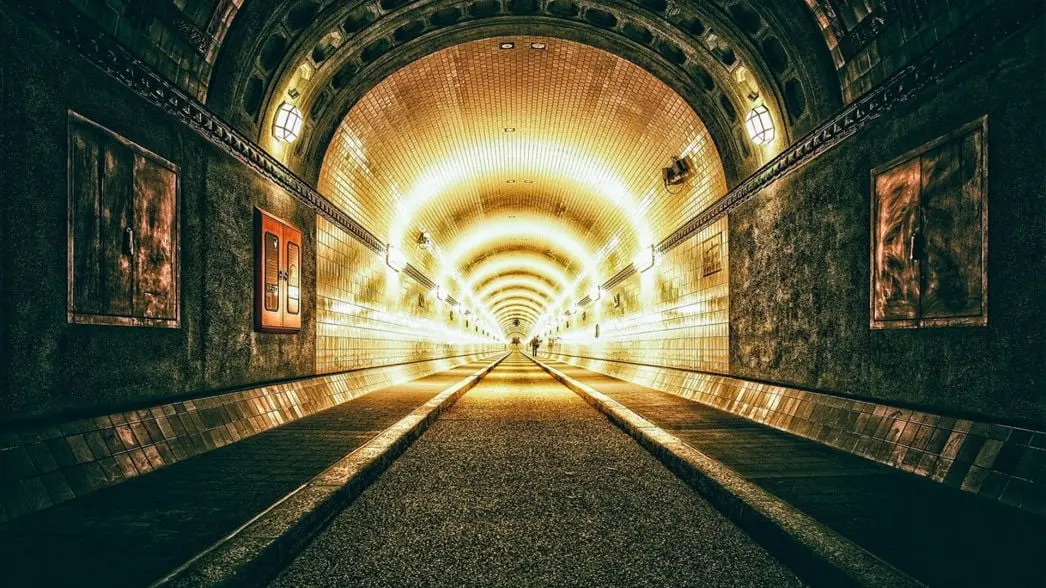
17. St. Nicholas’ Church (Mahnmal St-Nikolai)
Another very important place to see in Hamburg is St. Nicholas’ Church.
It was built in 1335, in the place where there was once a chapel dedicated to St. Nicholas, patron saint of sailors. The Baltic Gothic style construction resisted until the middle of the 19th century until it burned down during the great fire of 1842. A few years later, the English architect, George Gilbert Scott, was commissioned to rebuild the monument. He then designed a nave 86 meters long and a vault 28 meters high, strongly influenced by the French and English Gothic styles. The 147-meter high spire was finished in 1874.
At that time, the church of St. Nicholas had the honor of becoming the tallest building in the world for 2 years, until the completion of the cathedral of Rouen in France in 1876. After the television tower, built at the end of the 19th century, the church tower is still the second-highest building in Hamburg.
It is currently in ruins and serves as a memorial. This ruinous state was caused by bombing during World War II. But why was the tower not hit by any bombs? The answer is very simple: the Allies used this tower, along with St. Peter's and City Hall, to position themselves, and for this reason, they were not destroyed.
In the subterranean crypt, an exhibition tells the story of three events during the Second World War: the bombing of Coventry in 1940, the German destruction of Warsaw, and Operation Gomorrah, which consisted of the Allied bombing of the city of Hamburg over three days and nights. The result was shocking: more than 70% of the city was in ruins and almost 40,000 people were dead.
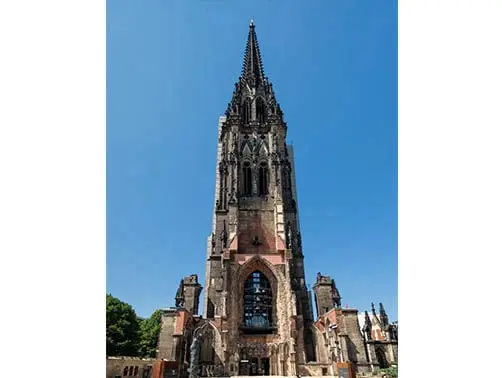
18. Hamburger Kunsthalle
If you are an art lover, the Kunsthalle, the Hamburg Art Museum, should be at the top of your list of things to do.
Founded in 1850 by the Hamburg artists' association, it began as a local exhibition space. Given the recognition and support of civil society, the collection was progressively increased and a new space was required. Thus, the new architectural project was commissioned to Georg Theodor Schirrmacher and Hermann Von Der Hude, who completed construction in 1869, consolidating the collection with German and European works of medieval art.
In 1919, Gustav Pauli expanded the museum into a new building. Taking advantage of the move, Pauli reorganized the collection chronologically and acquired new works with an emphasis on modern art. The third building that makes up the museum was built in 1997.
You can admire paintings here by the most important artists of the German Quattrocento, as well as works by Dutch painters from the 17th century and paintings by Italian and French artists from the 16th, 17th, and 18th centuries.
The collection consists of artists such as Runge, Friedrich, Feuerbach, Böcklin, Menzel, Leibl, Courbet, Corot, Degas, Toulouse-Lautrec, Gauguin, Renoir, Manet, Monet, Giambattista Tiepolo, Sisley, Cézanne, and Lieberman, among others.
Audio guide devices, Multimedia audio guides,
Audio guide GPS tourist bus-train, charging bases and accessories.
Group guidance systems, headsets, charging cases, tour guide systems accessories.
Audioguides available from mobile devices, web App, downloadable App from Google Store.
Audioguides in several languages, translations, voiceovers. Audio descriptions, signoguides, visual contents for audioguides. 3D Reality.